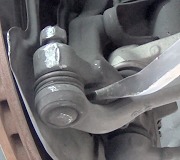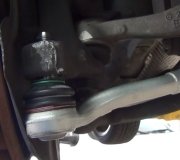Huh? I like that store but the majority of parts guys never were mechanics. Joints that have grease fittings have them for a reason, ... To allow them to be greased. There are some designs that do not require periodic maintenance. Those will not have grease fittings or a place to put one. If that's what they sold you, then yes, he's right. A lot of vehicles come from the factory now with non-greaseable ball joints and tie rod ends, but that is to save money. Ford started the trend in the mid '70s when they left four grease fittings off their cars. The rationale was "they cost five cents a piece; leave four off a million cars and we save four million nickels". They had a real lot of trouble with ball joints but those cars were always out of warranty when they started squeaking. If not addressed right away, it was common for them to separate within less than 1000 miles. It might sound silly, but if any manufacturer found a way to save one cent on building each car back then, that was big news and someone was sure to get a pat on the back. They came up with a different major disaster in the mid '80s called the "rubber-bonded-socket". We called them "killer cars" because there were so many crashes from those parts falling apart just a few hundred miles after they were inspected. Most of those cars have been off the road for many years. There were problems on Suburbans with squeaking lower ball joints. People were drilling holes in them to install grease fittings. I doubt that was a factory-approved recommendation because there would be no way for that grease to get to the ball and socket, and I've been warned that petroleum-based grease will deteriorate the nylon insert that puts the pressure on the ball. In that case I would be replacing them with ball joints that require periodic greasing. Until that squeaking problem, GM had no more trouble than anyone else with those front end parts.
I don't mean to pick on your Jimmy, but understand that worn and sloppy ball joints are very common on them. It's what we call "the nature of the beast". There is nothing wrong with the design; it's just a well known characteristic and nothing anyone has been able to do about it. We worked on students' and faculty members' cars at my community college and we saw the same Blazers come in about every two years for the same ball joints over and over. I asked at classes sponsored by NAPA and Carquest and all I got for an answer was "we sell a lot of them". I even attended a Federal Mogul class in St. Louis where they design and manufacture improved parts, and the closest I got was a suggestion it is related being a skinny vehicle with short control arms that go through big arcs as the vehicle goes up and down on bumpy roads. I don't know if that's really the cause but it beats anything else I've heard.
As far as "busting the boots", that's how I know you were talking with a salesman, not a mechanic. The boot is there to keep dirt and water out. When you grease the joint you will see the boot balloon up a little. That is plenty of grease. For those of us who think some is good so more must be better, every boot has a notch to allow extra grease to escape. Some people think the goal is for the new grease to push the old grease out through that relief hole. If you see droplets of water squeezing out, then yes, keep adding grease. If you see reddish-colored rust oozing out, some wear has already taken place and all the grease in my driveway isn't going to solve that.
Now let me give you some suggestions you can really use. Don't be angry with your Jimmy if it needs ball joints again in a few years. Instead, keep an eye on the front tire wear. I can give you some pointers on that too but it's easier to learn what to look for if you have someone right there to show you. In the absence of unacceptable tire wear, a little sloppiness in the ball joints may go unnoticed. They do not separate and cause crashes as is common on Ford front-wheel-drive cars. Rather, they will cause clunking sounds when cornering and going over bumps. They will give you plenty of warning. There's a good chance we were replacing so many at school because we were using those cars every year to teach students how to perform inspections. Otherwise those owners would likely have driven their vehicles many more years without noticing a problem.
You might consider looking for a community college with an Automotive program. We were always looking for live work to give our kids real-world learning experiences. They are well-supervised and conscientious, but you will be restricted to only having work done that fits with what they are currently studying so they don't take work away from the community. If they accept your car, expect to be without it for up to a week until it fits in with their teaching schedule. In return you will get a very small bill. We charged a tiny markup on parts and $10.00 per hour for what the work was supposed to take. Four ball joints and an alignment would likely cost less than $250.00.
I have more good news if you want to replace the ball joints yourself when the time comes. On your Jimmy, the lower ball joints are pressed-in designs. You'll need a ball joint press that you might be able to rent or borrow from a parts store that borrows tools. To buy that tool now can cost WAY less than $100.00. It looks like a really beefy c-clamp with some discs and three round pieces of pipe. It's actually easy to use. The majority of your time involves taking things apart to get to the lower joint. When you know what you're doing, the procedure for just the one lower joint takes about an hour. If that is all that you replace, it is very possible you will not need an alignment because you are replacing a ball that is perfectly centered in a round socket, in the middle of a round housing that fits snugly in a round hole in the control arm. That means the stud of the joint will be in the exact same place the old one was when it was new. That puts the lower part of the wheel right back in the same perfect alignment where it used to be.
While the lack of needing an alignment might sound nice, alignment angles can also change over time due to sagged front springs so having that alignment performed is still a good idea. Most, if not all of the smaller Blazers use the same style torsion bar spring that Chrysler used all through the '60s and '70s. They are tough and best of all, they are adjustable. If you visit any tire and alignment shop, they will have a small booklet that shows you where to take measurements with a tape measure, and what those measurements should be. By checking and adjusting the torsion bars every few years, that will help reduce tire wear.
The really good news has to do with the upper ball joints. They were held onto the upper control arms with really tough rivets than can be somewhat hard to remove. Your new joints are held on with four bolts and nuts which are easy to remove. From now on replacing those doesn't involve much more than removing the wheel and five nuts, and separating the joint from the knuckle. One can be done in 15 minutes, but since these mount differently, they are subject to production tolerances so an alignment should be performed. The vehicle will still be drivable because even if the alignment is off, it won't be by very much.
The best way to learn how to replace ball joints of these styles is with an automotive textbook. Manufacturer's service manuals provide the exact steps for a specific vehicle but the instructions are written for people who understand the overall procedure already. Textbook instructions are written for people who have never done this before, ... And they have pictures!
Hope that gives you some ideas and peace of mind.
Sunday, June 12th, 2011 AT 5:43 AM



